
Charlemagne or Charles the Great, a member of the Carolingian dynasty, was King of the Franks from 768, King of the Lombards from 774, and was crowned as the Emperor of the Romans by the Papacy in 800. Charlemagne succeeded in uniting the majority of western and central Europe and was the first recognized emperor to rule from western Europe after the fall of the Western Roman Empire approximately three centuries earlier. The expanded Frankish state that Charlemagne founded was the Carolingian Empire, which is considered the first phase in the history of the Holy Roman Empire. He was canonized by Antipope Paschal III—an act later treated as invalid—and he is now regarded by some as beatified in the Catholic Church.

The Battle of Benevento was a major medieval battle fought on 26 February 1266, near Benevento in present-day Southern Italy, between the forces of Charles I of Anjou and those of King Manfred of Sicily. Manfred's defeat and death resulted in Charles' conquest of the Kingdom of Sicily, effectively ending the rule of the Hohenstaufen dynasty in the Italian Peninsula and marking the rise of the royal Capetian House of Anjou. The engagement was part of the conflict which pitted Guelphs against Ghibellines.
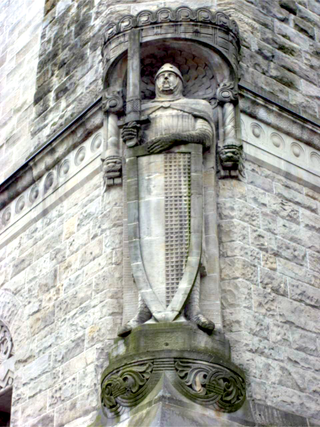
Roland was a Frankish military leader under Charlemagne who became one of the principal figures in the literary cycle known as the Matter of France. The historical Roland was military governor of the Breton March, responsible for defending Francia's frontier against the Bretons. His only historical attestation is in Einhard's Vita Karoli Magni, which notes he was part of the Frankish rearguard killed in retribution by the Basques in Iberia at the Battle of Roncevaux Pass.

The Battle of Manzikert or Malazgirt was fought between the Byzantine Empire and the Seljuk Empire on 26 August 1071 near Manzikert, theme of Iberia. The decisive defeat of the Byzantine army and the capture of the Emperor Romanos IV Diogenes played an important role in undermining Byzantine authority in Anatolia and Armenia, and allowed for the gradual Turkification of Anatolia. Many Turks, travelling westward during the 11th century, saw the victory at Manzikert as an entrance to Asia Minor.

The Song of Roland is an 11th-century chanson de geste based on the Frankish military leader Roland at the Battle of Roncevaux Pass in AD 778, during the reign of the Carolingian king Charlemagne. It is the oldest surviving major work of French literature. It exists in various manuscript versions, which testify to its enormous and enduring popularity in Medieval and Renaissance literature from the 12th to 16th centuries.
Túrin Turambar is a fictional character in J. R. R. Tolkien's legendarium. Turambar and the Foalókë, begun in 1917, is the first appearance of Túrin in the legendarium. Túrin is a Man of the First Age of Middle-earth, whose family had been cursed by the Dark Lord Morgoth. While trying vainly to defy the curse, Túrin brings ruin across much of Beleriand, and upon himself and his sister Niënor. His title, "Turambar", means master of fate.

Renaudde Montauban was a legendary hero and knight which appeared in a 12th-century Old French chanson de geste known as The Four Sons of Aymon. The four sons of Duke Aymon are Renaud, Richard, Alard and Guiscard, and their cousin is the magician Maugris. Renaud possesses the magical horse Bayard and the sword Froberge.
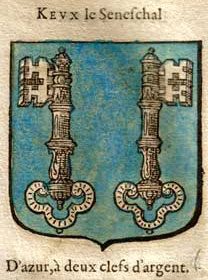
In Arthurian legend, Sir Kay is King Arthur's foster brother and later seneschal, as well as one of the first Knights of the Round Table. In later literature he is known for his acid tongue and bullying, boorish behaviour, but in earlier accounts he was one of Arthur's premier warriors. Along with Bedivere, with whom he is frequently associated, Kay is one of the earliest characters associated with Arthur. Kay's father is called Ector in later literature, but the Welsh accounts name him as Cynyr Ceinfarfog.

Harold Theopolis "Harry" Osborn is a fictional character appearing in American comic books published by Marvel Comics, commonly in association with the superhero Spider-Man. Created by Stan Lee and Steve Ditko, the character first appeared in The Amazing Spider-Man #31.

Joyeuse was, in medieval legend, the sword wielded by Charlemagne as his personal weapon. A sword identified as Joyeuse was used in French royal coronation ceremonies since the 13th century, and is now kept at the Louvre Museum.

Oliver, sometimes referred to as Olivier de Vienne or de Gennes, is a legendary knight in the Matter of France chansons de geste, especially the French epic The Song of Roland. In the tradition, he was Roland's closest friend, advisor, confidant and brother-in-law to be, one of Charlemagne's twelve peers and brother of Aude, Roland's betrothed. He dies with Roland at the Battle of Roncevaux Pass. Some critics have linked his name to the olive tree, a biblical symbol of divine wisdom.
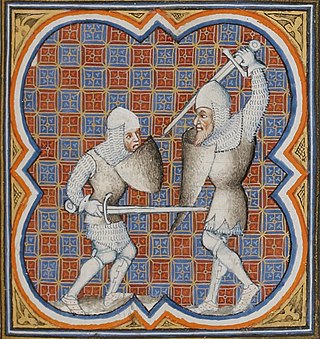
Ferragut was a character—a Saracen paladin, sometimes depicted as a giant—in texts dealing with the Matter of France, including the Historia Caroli Magni, and Italian epics, such as Orlando Innamorato by Matteo Maria Boiardo and Orlando Furioso by Ludovico Ariosto. In the tales, he was portrayed as physically invulnerable except at his navel/stomach, and was eventually killed by the paladin Roland.

The Historia Caroli Magni, also known as the Historia Karoli Magni et Rotholandi or the (Pseudo-)Turpin Chronicle, is a 12th-century Latin chronicle consisting of legendary material about Charlemagne's campaigns in Spain. The chronicle states it was written by Charlemagne's contemporary Turpin, Archbishop of Reims, but it was found out as a medieval forgery. The work was extremely popular, and served as a major source of material on Charlemagne in chronicles, fiction and iconography throughout Medieval Europe. The miracles of the flowering lances and the death of Ferracutus appear on the windows of Chartres cathedral.

The period of Anglo-Saxon warfare spans the 5th century AD to the 11th in Anglo-Saxon England. Its technology and tactics resemble those of other European cultural areas of the Early Medieval Period, although the Anglo-Saxons, unlike the Continental Germanic tribes such as the Franks and the Goths, do not appear to have regularly fought on horseback.

Ruslan and Ludmila is a poem by Alexander Pushkin, published in 1820. It is written as an epic fairy tale consisting of a dedication (посвящение), six "cantos", and an epilogue. It tells the story of the abduction of Ludmila, the daughter of Prince Vladimir of the Kievan Rus', by an evil wizard and the attempt by the brave knight Ruslan to find and rescue her.
"King Arthur and King Cornwall" is an English ballad surviving in fragmentary form in the 17th-century Percy Folio manuscript. An Arthurian story, it was collected by Francis James Child as Child Ballad 30. Unlike other Child Ballads, but like the Arthurian "The Boy and the Mantle" and "The Marriage of Sir Gawain", it is not a folk ballad but a professional minstrel's song. It is notable for containing the Green Knight, a character known from the medieval poems The Greene Knight and the more famous Sir Gawain and the Green Knight; he appears as "Bredbeddle", the character's name in The Greene Knight.
Chanson d'Aspremont is a 12th-century Old French chanson de geste. The poem comprises 11, 376 verses, grouped into rhymed laisses. The verses are decasyllables mixed with alexandrines.
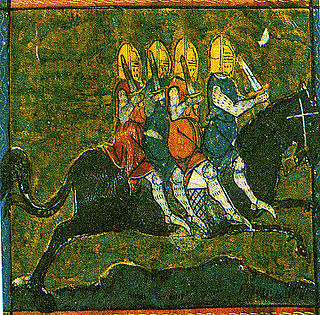
The Four Sons of Aymon, sometimes also referred to as Renaud de Montauban is a medieval tale spun around the four sons of Duke Aymon: the knight Renaud de Montauban, his brothers Guichard, Allard and Richardet, their magical horse Bayard, their adventures and revolt against the emperor Charlemagne. The story had a European success and echoes of the story are still found today in certain folklore traditions.
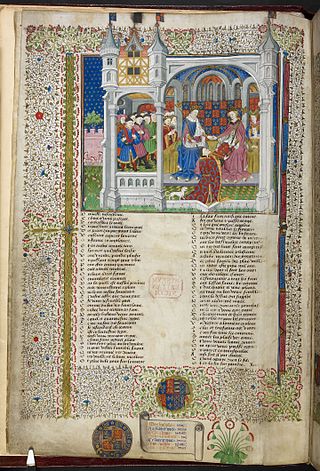
The Talbot Shrewsbury Book is a very large richly-illuminated manuscript made in Rouen (Normandy) in 1444/5. It was presented by John Talbot, 1st Earl of Shrewsbury to the French princess, Margaret of Anjou, in honour of her betrothal to King Henry VI. It contains a unique collection of fifteen texts in French, including chansons de geste, chivalric romances, treatises on warfare and chivalry, and finally the Statutes of the Order of the Garter. The work is an excellent example of book production in Rouen in the mid-fifteenth century and provides a rare insight into the political views of the English military leader and close confidant of the crown, John Talbot.















